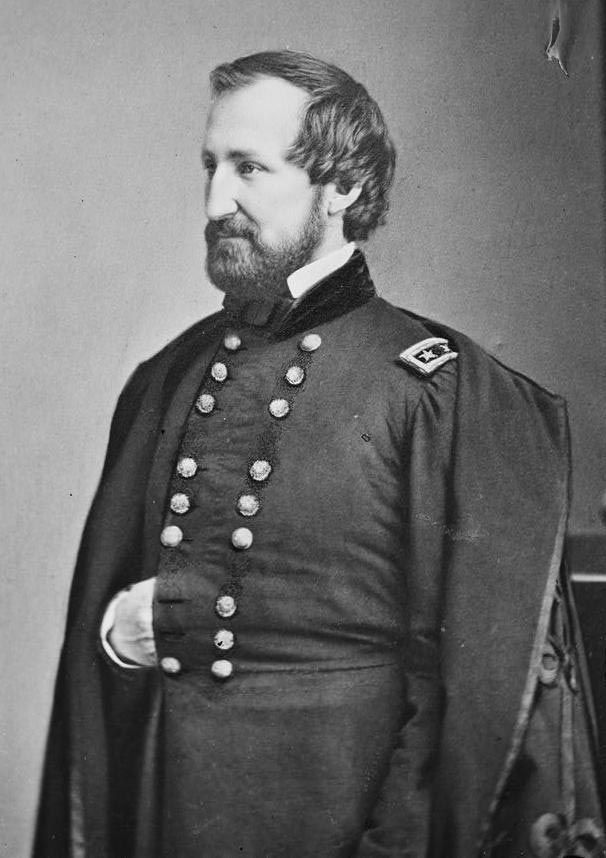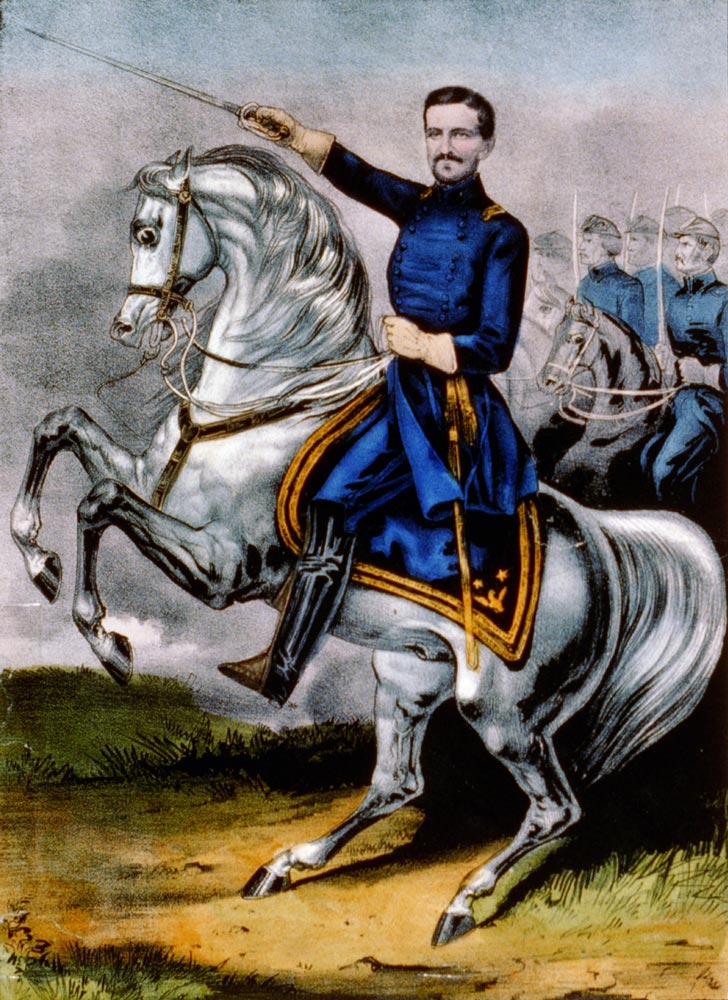| William Rosecrans | |
|---|---|
 |
|
| Born | Sep. 6, 1819 Delaware County, Ohio |
| Died | Mar. 11, 1898 (aged 78) Redondo Beach, California |
| Allegiance | United States of America Union |
| Rank | Major General (1842–54, 1861–67) |
| Battles/wars | American Civil War Battle of Rich Mountain Battle of Iuka Second Battle of Corinth Battle of Stones River Tullahoma Campaign Battle of Chickamauga Price’s Raid |
William Starke Rosecrans was a 19th century American soldier who played a significant part in the American Civil War, and who rose to the rank of general. He was born in Delaware County in Ohio in September 1819. His father Crandall had also been a serving soldier who took part in the War of 1812.
Early Life
Rosecrans received little formal education in his early years, but he managed to teach himself a lot by reading extensively. He began work as a clerk in a store in Utica when he was just thirteen. He successfully applied for entry to the West Point Military Academy and graduated fifth in his class in 1842.
He was appointed to the engineering corps as a second Lieutenant and served at Fort Monroe in Virginia, where he was tasked with designing and building sea walls. He requested and was granted a teaching position at West Point, where he remained until 1854. During this period, he was put in charge of several important engineering projects.
Resignation
A combination of poor health and financial difficulties made him resign his military commission in 1854. In the non-military business world, he was remarkably successful. He ran a profitable mining business, became involved in major civil engineering works and applied for several patents for new inventions.
He was severely injured in a fire following an explosion in 1859, and it took him a year and a half to recover. His recovery coincided with the outbreak of the Civil War, and Rosecrans rejoined the Federal Army and was sent to serve under Major General George B. McClellan. In May 1861, Rosecrans was promoted to the rank of Brigadier General.
Rosecrans established himself as a master strategist during the West Virginia Campaign and is regarded by many military historians as the brains behind the early Federal victories at Corrick’s Ford and Rich Mountain. McClellan failed to mention Rosecrans’ contribution in military dispatches, something that was to cause friction between the two.
 He is also credited with preventing the Confederate attempt to invade West Virginia. Rosecrans’ planning and strategy meant the Federal forces managed to thwart the Confederates without getting involved in costly battles. Following the defeat of McClellan’s troops at the First Battle of Bull Run, McClellan was appointed to an administrative role in Washington, and Rosecrans was appointed to overall command of the West Virginia army.
He is also credited with preventing the Confederate attempt to invade West Virginia. Rosecrans’ planning and strategy meant the Federal forces managed to thwart the Confederates without getting involved in costly battles. Following the defeat of McClellan’s troops at the First Battle of Bull Run, McClellan was appointed to an administrative role in Washington, and Rosecrans was appointed to overall command of the West Virginia army.
In the fall of 1861, Rosecrans was working on plans to capture the town of Winchester in Virginia, putting pressure on the Confederate forces at Manassas. McClellan overruled his plan, believing it would fail. Instead, he moved most of Rosecrans’ troops to another command, leaving Rosecrans with just 2,000 troops, essentially making him inactive. Shortly afterwards, in March 1862, Rosecrans’ remaining troops were placed under General John C. Fremont, leaving Rosecrans without a command.
Moving briefly to Washington, Rosecrans disagreed on tactics and strategies proposed by senior officers to tackle Stonewall Jackson in the Shenandoah Valley campaign. This greatly irritated Edwin M. Stanton, the Secretary of War. Annoyed by the political interference and together with his unwillingness to work with McClellan, he requested a move to the west. In May 1862, he was sent to serve under Major General John Pope with the Army of the Mississippi. He was placed as an officer commanding two divisions.
After the Union success at the Siege of Corinth, which lasted from April 29 to May 30 in 1862, Rosecrans was placed in overall charge of the army, reporting to Major General Ulysses S. Grant. During September and October 1862, he took a leading role in the Iuka-Corinth campaign.
Battle of Luka
The Confederate Major General Sterling Price was encamped at Iuka where he intended to wait for reinforcements under Major General Earl Van Dorn, before launching attacks on Grant’s Federal troops.
Rather than wait for this to happen, Grant agreed with a Rosecrans plan to attack Price before any reinforcements arrived. The Federal plan was to attack Iuka from two different directions. Troops under the command of Brigadier General Edward Ord were to attack from the northwest, while Rosecrans’ troops would attack from southwest.
Rosecrans’ men were delayed by the poor quality of the roads and navigation errors, and Ord’s men were positioned near Iuka a full day before Rosecrans would arrive. Grant ordered Ord to wait until Rosecrans arrived, and forbade any encounters with the Confederate forces until Rosecrans’ men were already engaged.
On September 19, Rosecrans arrived and began fighting Confederate troops in a pitched battle that began around 4:30 pm. Because of weather conditions, Ord’s men were completely unaware that Rosecrans was engaged in battle. When fighting stopped that night, Rosecrans and Ord planned for the battle they were sure would take place the following day, but the Confederates withdrew. Rosecrans gave chase, but by this stage his troops were exhausted, and they failed to catch the Confederates.
Return to Corinth
While the campaign had succeeded in its objective of driving the Confederates out of Iuka, it failed to prevent Price and Van Dorn’s troops from linking up, which they did on September 28. The blame for this failure led to recriminations between Grant and Rosecrans, which were exacerbated by further disagreements on future strategy. Grant instructed Rosecrans to return to Corinth, correctly believing that the Confederates would try to retake it. Rosecrans disagreed with Grant, feeling that the Confederates might attack the Mobile and Ohio railroad.
This might explain why Rosecrans was slow to react when the Confederates launched their assault on his defenses on October 3. Initially, the Confederate drive was successful and at the end of the first day, Rosecrans’ troops had been driven back. However, Rosecrans’ men managed to repel the assault the following day, and the Confederates withdrew.
Rosecrans received praise from President Lincoln following his performance at the Battle of Stones River, where he rallied his troops by riding along the line, at great personal risk, shouting encouragement.
He was appointed commander of the Army of the Cumberland. He resisted pressure from Washington to launch offensives against the Confederates, citing the weather and the need to reinforce his troops. After six months, he led his troops in the successful Tullahoma campaign. He suffered a defeat in the Chickamauga Campaign, which was his last action in the Civil War.